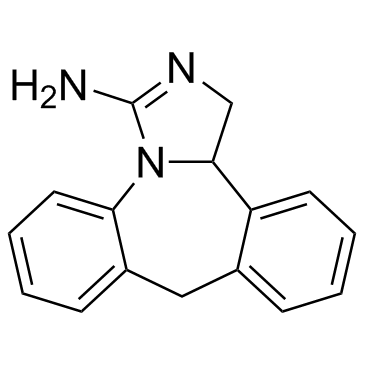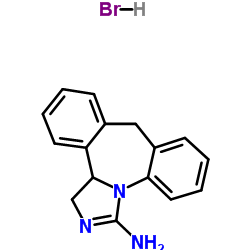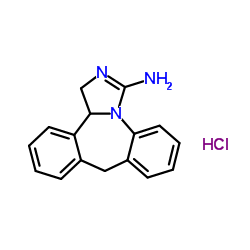Epinastine
Modify Date: 2024-01-04 18:23:07

Epinastine structure
|
Common Name | Epinastine | ||
|---|---|---|---|---|
| CAS Number | 80012-43-7 | Molecular Weight | 249.31000 | |
| Density | 1.32 g/cm3 | Boiling Point | 428ºC at 760 mmHg | |
| Molecular Formula | C16H15N3 | Melting Point | 270ºC | |
| MSDS | N/A | Flash Point | 212.7ºC | |
Use of EpinastineEpinastine(WAL801) is an antihistamine and mast cell stabilizer that is used in eye drops to treat allergic conjunctivitis.Target: Histamine ReceptorEpinastine shows a high affinity to H1-receptors in receptor binding studies in the guinea pig ileum. Epinastine inhibits histamine-induced reactions in the skin or the lung of rats, dogs and guinea pigs [1]. Epinastine is able to displace specific [3H]NC-5Z binding at low concentrations in the locust nervous tissue. Epinastine binds to the honey bees neuronal octopamine receptor with Ki of 1.1 nM. Epinastine antagonises octopamine-induced cAMP formation in the insect brain [2]. Epinastine causes an inhibition of histamine release from rat peritoneal mast cells induced by both antigen-antibody reaction and compound 48/80. Epinastine is similarly effective in inhibiting compound 48/80-induced histamine release not only from isolated rat peritoneal mast cells but also from rat mesenterial pieces. Epinastine is effective in inhibiting not only Ca2+ uptake into lung mast cells in actively sensitized guinea pigs but also Ca2+ release from the intracellular Ca store of rat peritoneal mast cells exposed to both compound 48/80 and substance P [3]. Epinastine shows a dose- and time-dependent suppressive effect on IL-8, one of the chemokines for eosinophils, released from eosinophils isolated from atopic diseases [4]. |
| Name | epinastine |
|---|---|
| Synonym | More Synonyms |
| Description | Epinastine(WAL801) is an antihistamine and mast cell stabilizer that is used in eye drops to treat allergic conjunctivitis.Target: Histamine ReceptorEpinastine shows a high affinity to H1-receptors in receptor binding studies in the guinea pig ileum. Epinastine inhibits histamine-induced reactions in the skin or the lung of rats, dogs and guinea pigs [1]. Epinastine is able to displace specific [3H]NC-5Z binding at low concentrations in the locust nervous tissue. Epinastine binds to the honey bees neuronal octopamine receptor with Ki of 1.1 nM. Epinastine antagonises octopamine-induced cAMP formation in the insect brain [2]. Epinastine causes an inhibition of histamine release from rat peritoneal mast cells induced by both antigen-antibody reaction and compound 48/80. Epinastine is similarly effective in inhibiting compound 48/80-induced histamine release not only from isolated rat peritoneal mast cells but also from rat mesenterial pieces. Epinastine is effective in inhibiting not only Ca2+ uptake into lung mast cells in actively sensitized guinea pigs but also Ca2+ release from the intracellular Ca store of rat peritoneal mast cells exposed to both compound 48/80 and substance P [3]. Epinastine shows a dose- and time-dependent suppressive effect on IL-8, one of the chemokines for eosinophils, released from eosinophils isolated from atopic diseases [4]. |
|---|---|
| Related Catalog | |
| References |
| Density | 1.32 g/cm3 |
|---|---|
| Boiling Point | 428ºC at 760 mmHg |
| Melting Point | 270ºC |
| Molecular Formula | C16H15N3 |
| Molecular Weight | 249.31000 |
| Flash Point | 212.7ºC |
| Exact Mass | 249.12700 |
| PSA | 41.62000 |
| LogP | 2.66770 |
| Index of Refraction | 1.727 |
| Storage condition | 2-8℃ |
|
Material Safety Data Sheet
Section1. Identification of the substance Product Name: Epinastine Synonyms: Section2. Hazards identification Harmful by inhalation, in contact with skin, and if swallowed. Section3. Composition/information on ingredients. Ingredient name:Epinastine CAS number:80012-43-7 Section4. First aid measures Skin contact:Immediately wash skin with copious amounts of water for at least 15 minutes while removing contaminated clothing and shoes. If irritation persists, seek medical attention. Eye contact:Immediately wash skin with copious amounts of water for at least 15 minutes. Assure adequate flushing of the eyes by separating the eyelids with fingers. If irritation persists, seek medical attention. Inhalation:Remove to fresh air. In severe cases or if symptoms persist, seek medical attention. Ingestion:Wash out mouth with copious amounts of water for at least 15 minutes. Seek medical attention. Section5. Fire fighting measures In the event of a fire involving this material, alone or in combination with other materials, use dry powder or carbon dioxide extinguishers. Protective clothing and self-contained breathing apparatus should be worn. Section6. Accidental release measures Personal precautions: Wear suitable personal protective equipment which performs satisfactorily and meets local/state/national standards. Respiratory precaution:Wear approved mask/respirator Hand precaution:Wear suitable gloves/gauntlets Skin protection:Wear suitable protective clothing Eye protection:Wear suitable eye protection Methods for cleaning up: Mix with sand or similar inert absorbent material, sweep up and keep in a tightly closed container for disposal. See section 12. Environmental precautions: Do not allow material to enter drains or water courses. Section7. Handling and storage Handling:This product should be handled only by, or under the close supervision of, those properly qualified in the handling and use of potentially hazardous chemicals, who should take into account the fire, health and chemical hazard data given on this sheet. Store in closed vessels. Storage: Section8. Exposure Controls / Personal protection Engineering Controls: Use only in a chemical fume hood. Personal protective equipment: Wear laboratory clothing, chemical-resistant gloves and safety goggles. General hydiene measures: Wash thoroughly after handling. Wash contaminated clothing before reuse. Section9. Physical and chemical properties Appearance:Not specified Boiling point:No data No data Melting point: Flash point:No data Density:No data Molecular formula:C16H15N3 Molecular weight:249.3 Section10. Stability and reactivity Conditions to avoid: Heat, flames and sparks. Materials to avoid: Oxidizing agents. Possible hazardous combustion products: Carbon monoxide, nitrogen oxides. Section11. Toxicological information No data. Section12. Ecological information No data. Section13. Disposal consideration Arrange disposal as special waste, by licensed disposal company, in consultation with local waste disposal authority, in accordance with national and regional regulations. Section14. Transportation information Non-harzardous for air and ground transportation. Section15. Regulatory information No chemicals in this material are subject to the reporting requirements of SARA Title III, Section 302, or have known CAS numbers that exceed the threshold reporting levels established by SARA Title III, Section 313. SECTION 16 - ADDITIONAL INFORMATION N/A |
|
~93% 
Epinastine CAS#:80012-43-7 |
| Literature: USV LIMITED Patent: WO2009/63504 A2, 2009 ; Location in patent: Page/Page column 25 ; |
|
~% 
Epinastine CAS#:80012-43-7 |
| Literature: WO2009/63504 A2, ; Page/Page column 24 ; |
| Precursor 2 | |
|---|---|
| DownStream 1 | |
| EPINASTINE BASE |
| 9,13b-Dihydro-1H-dibenz[c,f]imidazo[1,5-a]azepin-3-amine |
| Flurinol(R) |
| 3-amino-9,13b-dihydro-1H-dibenz[c,f]imidazo[1,5-a]azepine |
| Epinastine |
| 3-Amino-9,13b-dihydro-1H-dibenzo[c,f]imidazo[1,5-a]azepine |
| MFCD00865648 |

![6-AMINOMETHYL-6, 11-DIHYDRO-5H-DIBENEZ[B,E]AZEPINE (E)-2-BUTENEDIOATE structure](https://image.chemsrc.com/caspic/179/127785-96-0.png)
 CAS#:108929-04-0
CAS#:108929-04-0